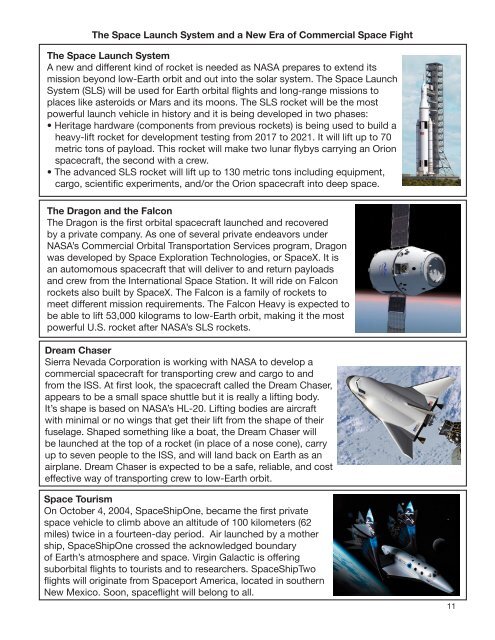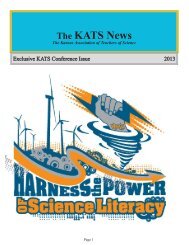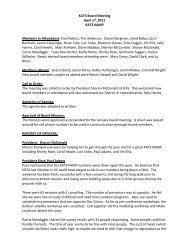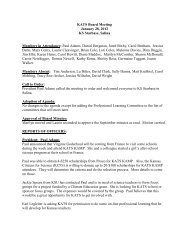Create successful ePaper yourself
Turn your PDF publications into a flip-book with our unique Google optimized e-Paper software.
The Space Launch System and a New Era of Commercial Space Fight<br />
The Space Launch System<br />
A new and different kind of <strong>rocket</strong> is needed as NASA prepares to extend its<br />
mission beyond low-Earth orbit and out into the solar system. The Space Launch<br />
System (SLS) will be used for Earth orbital flights and long-range missions to<br />
places like asteroids or Mars and its moons. The SLS <strong>rocket</strong> will be the most<br />
powerful launch vehicle in history and it is being developed in two phases:<br />
• Heritage hardware (components from previous <strong>rocket</strong>s) is being used to build a<br />
heavy-lift <strong>rocket</strong> for development testing from 2017 to 2021. It will lift up to 70<br />
metric tons of payload. This <strong>rocket</strong> will make two lunar flybys carrying an Orion<br />
spacecraft, the second with a crew.<br />
• The advanced SLS <strong>rocket</strong> will lift up to 130 metric tons including equipment,<br />
cargo, scientific experiments, and/or the Orion spacecraft into deep space.<br />
The Dragon and the Falcon<br />
The Dragon is the first orbital spacecraft launched and recovered<br />
by a private company. As one of several private endeavors under<br />
NASA’s Commercial Orbital Transportation Services program, Dragon<br />
was developed by Space Exploration Technologies, or SpaceX. It is<br />
an automomous spacecraft that will deliver to and return payloads<br />
and crew from the International Space Station. It will ride on Falcon<br />
<strong>rocket</strong>s also built by SpaceX. The Falcon is a family of <strong>rocket</strong>s to<br />
meet different mission requirements. The Falcon Heavy is expected to<br />
be able to lift 53,000 kilograms to low-Earth orbit, making it the most<br />
powerful U.S. <strong>rocket</strong> after NASA’s SLS <strong>rocket</strong>s.<br />
Dream Chaser<br />
Sierra Nevada Corporation is working with NASA to develop a<br />
commercial spacecraft for transporting crew and cargo to and<br />
from the ISS. At first look, the spacecraft called the Dream Chaser,<br />
appears to be a small space shuttle but it is really a lifting body.<br />
It’s shape is based on NASA’s HL-20. Lifting bodies are aircraft<br />
with minimal or no wings that get their lift from the shape of their<br />
fuselage. Shaped something like a boat, the Dream Chaser will<br />
be launched at the top of a <strong>rocket</strong> (in place of a nose cone), carry<br />
up to seven people to the ISS, and will land back on Earth as an<br />
airplane. Dream Chaser is expected to be a safe, reliable, and cost<br />
effective way of transporting crew to low-Earth orbit.<br />
Space Tourism<br />
On October 4, 2004, SpaceShipOne, became the first private<br />
space vehicle to climb above an altitude of 100 kilometers (62<br />
miles) twice in a fourteen-day period. Air launched by a mother<br />
ship, SpaceShipOne crossed the acknowledged boundary<br />
of Earth’s atmosphere and space. Virgin Galactic is offering<br />
suborbital flights to tourists and to researchers. SpaceShipTwo<br />
flights will originate from Spaceport America, located in southern<br />
New Mexico. Soon, spaceflight will belong to all.<br />
11










